
Sphagnum is a genus of approximately 380 accepted species of mosses, commonly known as sphagnum moss, also bog moss and quacker moss. Accumulations of Sphagnum can store water, since both living and dead plants can hold large quantities of water inside their cells; plants may hold 16 to 26 times as much water as their dry weight, depending on the species. The empty cells help retain water in drier conditions.
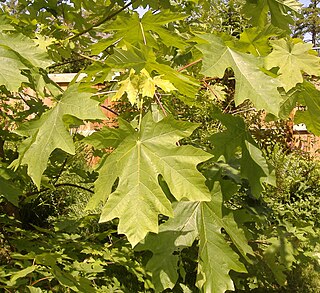
Acer macrophyllum, the bigleaf maple or Oregon maple, is a large deciduous tree in the genus Acer.

Drosera rotundifolia, the round-leaved sundew, roundleaf sundew, or common sundew, is a carnivorous species of flowering plant that grows in bogs, marshes and fens. One of the most widespread sundew species, it has a circumboreal distribution, being found in all of northern Europe, much of Siberia, large parts of northern North America, Korea and Japan but is also found as far south as California, Mississippi and Alabama in the United States of America and in New Guinea.

Scheuchzeria palustris, is a flowering plant in the family Scheuchzeriaceae, in which there is only one species and Scheuchzeria is the only genus. In the APG II system it is placed in the order Alismatales of the monocots.
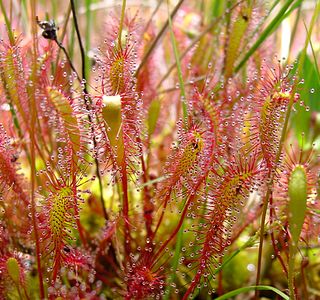
Drosera anglica, commonly known as the English sundew or great sundew, is a carnivorous flowering plant species belonging to the sundew family Droseraceae. It is a temperate species with a circumboreal range, although it does occur as far south as Japan, southern Europe, and the island of Kauai in Hawaii, where it grows as a tropical sundew. It is thought to originate from an amphidiploid hybrid of D. rotundifolia and D. linearis, meaning that a sterile hybrid between these two species doubled its chromosomes to produce fertile progeny which stabilized into the current D. anglica.

Rhododendron macrophyllum, the Pacific rhododendron, California rosebay, California rhododendron, coast rhododendron or big leaf rhododendron, is a large-leaved species of Rhododendron native to the Pacific Coast of North America. It is the state flower of Washington.

Neottia cordata, the lesser twayblade or heartleaf twayblade, is an orchid of upland bogs and mires that rarely exceeds 15 cm (5.9 in) in height. It was formerly placed in the genus Listera, but molecular phylogenetic studies have shown that Neottia nidus-avis, the bird's-nest orchid, evolved within the same group.
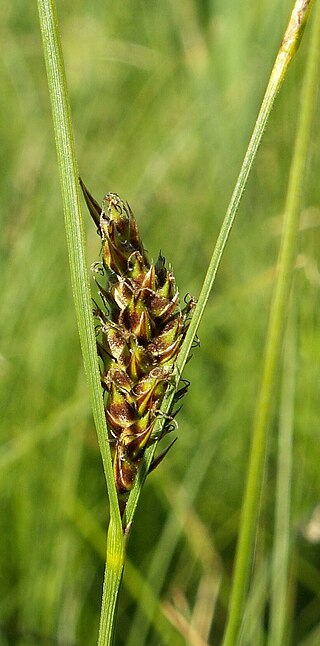
Carex lasiocarpa is a broadly distributed species of wetland sedge sometimes known as woollyfruit sedge or slender sedge. It is considered a species of Least Concern by the IUCN Red List due to its extensive range with many stable populations.
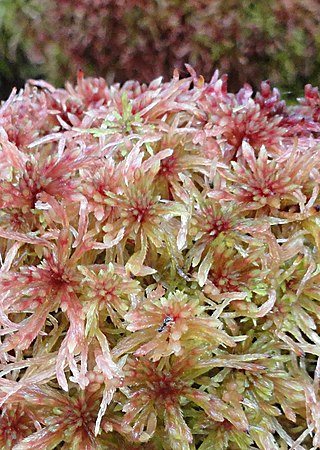
Sphagnum russowii, Russow's sphagnum or Russow's bogmoss, is a species of peat moss with a Holarctic distribution.
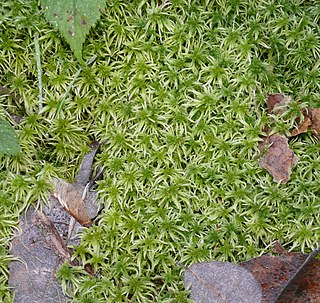
Sphagnum girgensohnii, also known as Girgensohn's bogmoss, Girgensohn's sphagnum or common green peat moss, is a species of peat moss with a Holarctic and Indo-Malesian distribution.
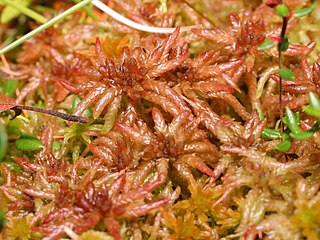
Sphagnum magellanicum, commonly called Magellanic bogmoss, Magellan's sphagnum, Magellan's peatmoss or midway peat moss, is a widespread species of moss found in wet boreal forest in the far south and southwest of South America, North America and Eurasia.

Orbexilum, commonly called leather-root, is a genus of flowering plants in the legume family (Fabaceae). They are native to North America, where they are found in the United States and Mexico, south to Chiapas.

Sphagnum palustre, the prairie sphagnum or blunt-leaved bogmoss, is a species of peat moss from the genus Sphagnum, in the family Sphagnaceae. Like other mosses of this type it can soak up water up to the 30-fold amount of its own dry weight thanks to its elastic spiral fibers. S. palustre is rather frequent and is spread almost all over the world. It mainly grows in wet forests and—compared to other specimens of this genus—rarely grows in moors.

Selaginella oregana is a species of spikemoss known by the common name Oregon spikemoss. It is native to the Pacific Coast of western North America, where it can be found from British Columbia to northern California. It grows in mossy, shady coastal forests. It is often epiphytic, growing attached to tree branches, its stems hanging in sheets of green, mosslike streamers. Trees commonly occupied by the spikemoss include bigleaf maple, black cottonwood, and red alder. It also grows on the ground and on rocks in carpetlike mats. This lycophyte has creeping or hanging stems up to about 60 centimeters long, usually with forking branches. They curl as they dry. The stems are radially symmetric, with spirals of lance-shaped leaves each measuring 2 or 3 millimeters in length and tipped with a tiny, rigid bristle. The strobili containing the reproductive structures are up to 6 centimeters long and often occur in pairs.

Sagittaria teres, the quill-leaved arrowhead or slender arrowhead, is an aquatic plant species in the genus Sagittaria native to the northeastern United States: Rhode Island, Massachusetts, New Hampshire, New York and New Jersey.

Sphagnum cuspidatum, the feathery bogmoss, toothed sphagnum, or toothed peat moss, is a peat moss found commonly in Great Britain, Norway, Sweden, the eastern coast of the United States, and in Colombia.
Carex arctiformis, the polar sedge, is a species of sedge native to sphagnum bogs and other wetlands in northwestern North America.

Trichophorum cespitosum, commonly known as deergrass or tufted bulrush, is a species of flowering plant in the sedge family. It was originally described by the Swedish naturalist Carl Linnaeus in 1753 as Scirpus cespitosus, but was transferred to the genus Trichophorum by the Swedish botanist Carl Johan Hartman in 1849, becoming Trichophorum cespitosum.
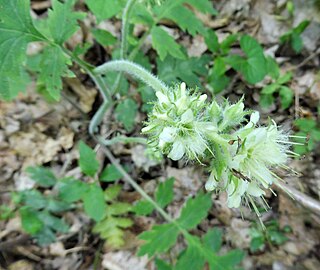
Hydrophyllum macrophyllum, commonly known as the hairy waterleaf or largeleaf waterleaf, is a species of plant in the borage family. It is native to the eastern United States where it is found primarily in the Midwest and Upper South.

Dasistoma macrophylla, commonly known as mullein foxglove, is a species of flowering plant in the broomrape family. It is monotypic, with no other species in the genus Dasistoma.


















